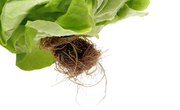
Respiration transforms the energy stored in foods eaten by an organism into energy that can be used for metabolic processes that sustain the organism's life. The importance of the respiratory system is critical; organisms can endure many days without food and sometimes a few without water, but cannot survive for more than a few minutes if respiration ceases.
Plants respire, but they predominantly engage in a process called photosynthesis. This shares characteristics with respiration, except with the relevant chemical reactions running in the reverse direction. Because respiration and photosynthesis complement each other across the planet's ecosystems, respiration is as vital to plants indirectly as it is to organisms that rely on respiration directly.
Respiratory System Organs
In humans and other vertebrates, air containing oxygen and carbon dioxide travels in and out of the body through the nose and mouth. After passing into the pharynx, or oral cavity, air moves down past the epiglottis, into the larynx and finally into the trachea or windpipe. The trachea splits into two main bronchi, which enter the right and left lungs. Eventually, air reaches the functional unit of the lung: the alveoli. These are tiny, thin-walled sacs, which carbon dioxide and oxygen can diffuse across the surfaces of. Carbon dioxide moves into the alveoli from the blood flowing through the lungs, while oxygen moves into the bloodstream.
In less specialized organisms such as worms, respiratory system function is simpler. Gases may simply diffuse across the outer surfaces of the body. Respiratory system parts vary across animals. Aquatic creatures possess gill slits to exchange gases with water, whereas insects contain a network of simple tracheae that carry gases directly to individual cells from the surface of the body.
Steps in Respiration
At the cellular level, proteins, carbohydrates and fats are broken down into small molecules such as glucose, which undergoes glycolysis. In this process, each six-carbon glucose molecule is broken down in a series of steps into two three-carbon pyruvate molecules, which yields a small amount of energy in the form of two molecules of ATP and two of NADH. This series of reactions does not require oxygen and is therefore called anaerobic respiration.
The two pyruvate molecules may undergo another series of reactions in the presence of oxygen, and this results in the release of significantly more ATP via the electron transport chain. This aerobic respiration results in the release of carbon dioxide and water vapor, both of which are exhaled or otherwise discharged into the environment. These processes are continually occurring throughout organisms' bodies to keep them alive and allow basic metabolic processes to unfold normally.
Respiration and Photosynthesis
Respiration takes oxygen and glucose and transforms them to water and carbon dioxide; photosynthesis uses carbon dioxide and water to synthesize glucose for the plants' needs, and releases oxygen. Given the enormous volume of both plant and animal life worldwide, it is certain that if plants all vanished today, animals would soon die off and vice versa.
Plants can engage in respiration, and do so in the dark when photosynthesis is dormant. At these times, the plants break down some of the glucose they have made to fuel growth and other processes. Then, when sunlight is again available, the plant returns to a net accumulation of glucose and releases oxygen via photosynthesis.
References
About the Author
Kevin Beck holds a bachelor's degree in physics with minors in math and chemistry from the University of Vermont. Formerly with ScienceBlogs.com and the editor of "Run Strong," he has written for Runner's World, Men's Fitness, Competitor, and a variety of other publications. More about Kevin and links to his professional work can be found at www.kemibe.com.
